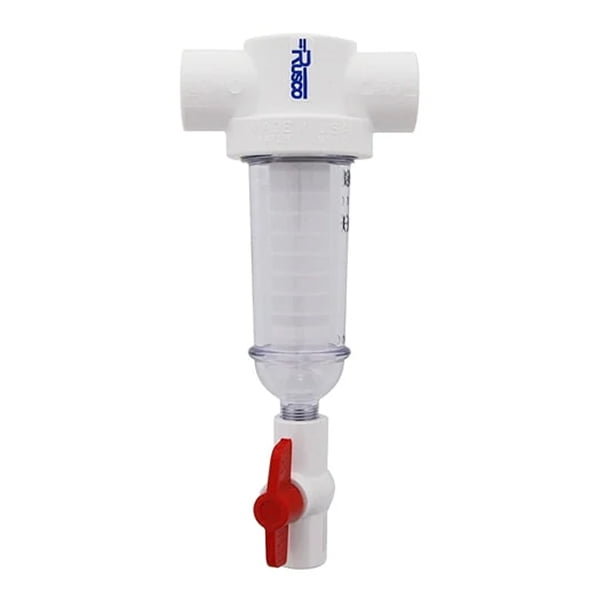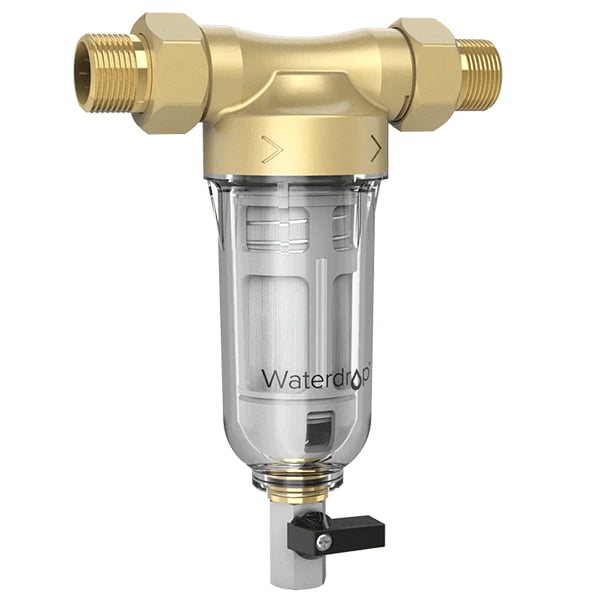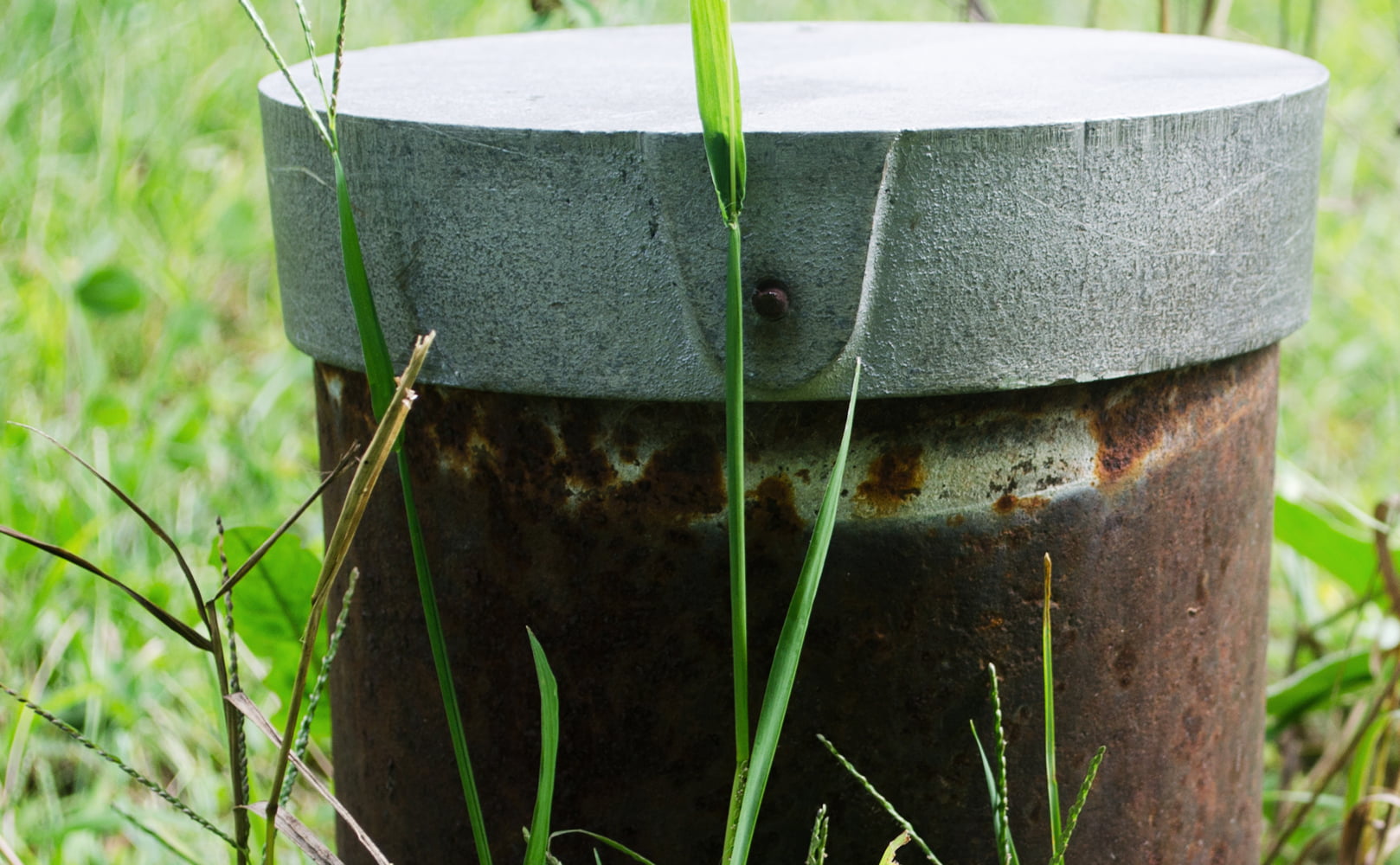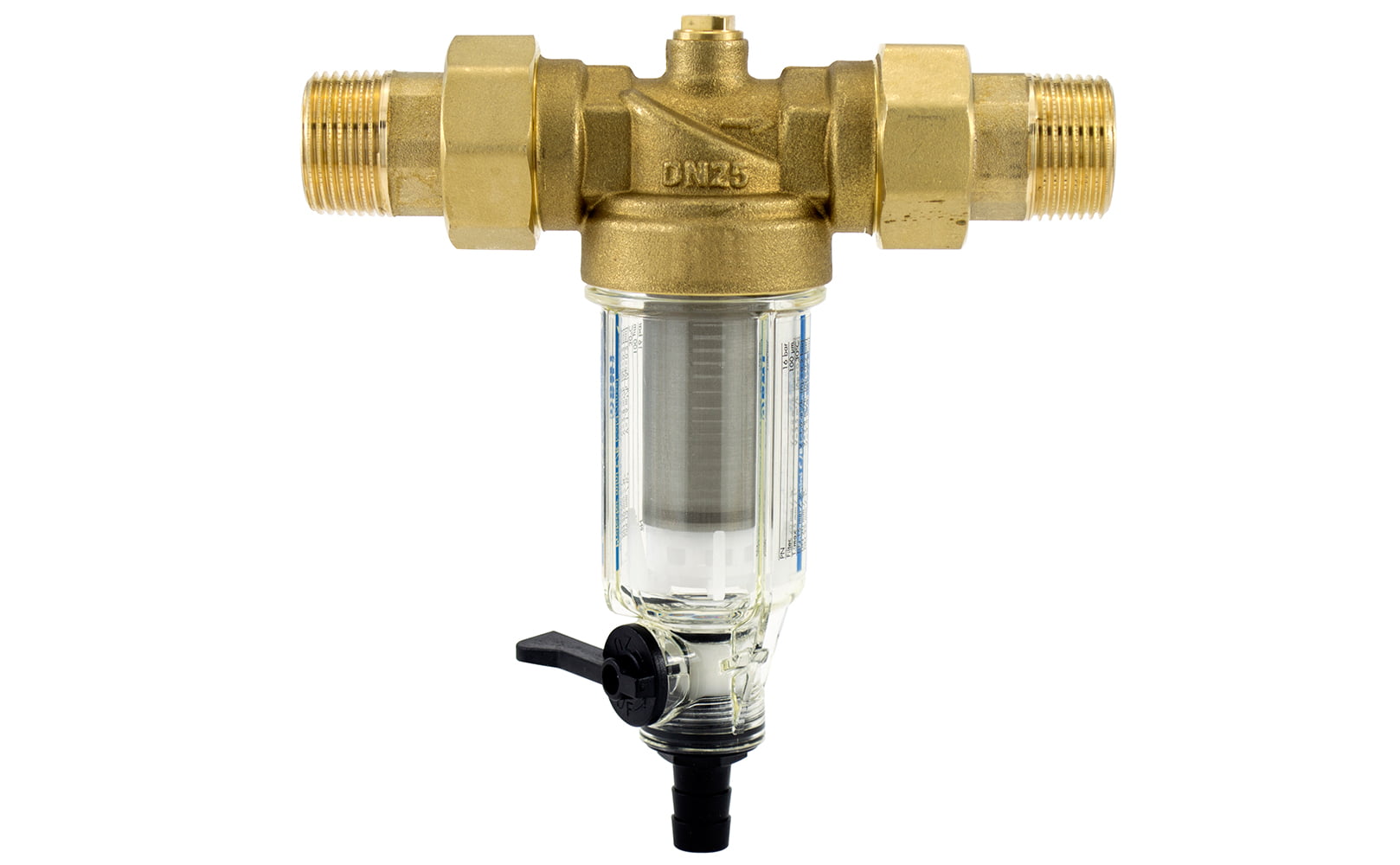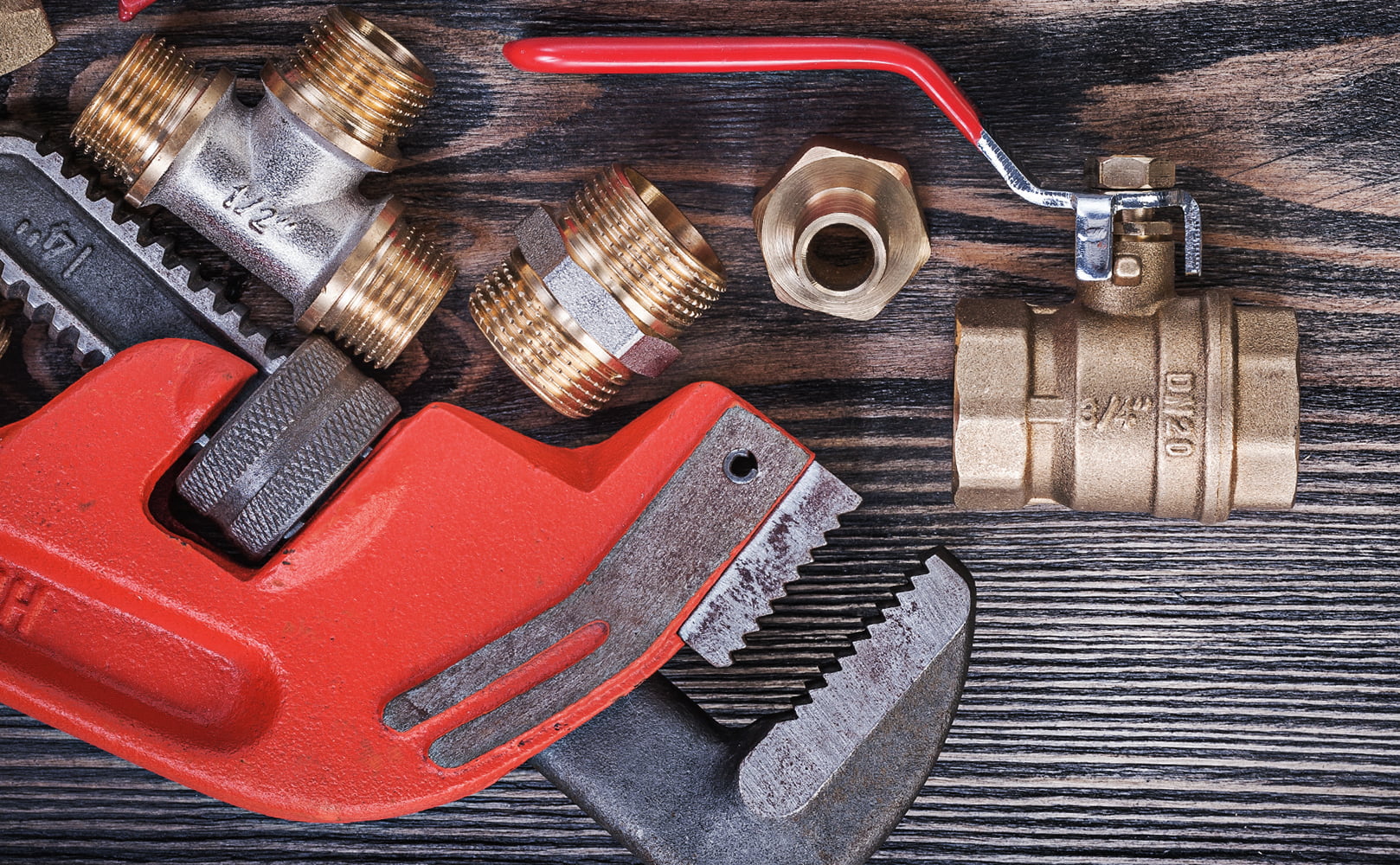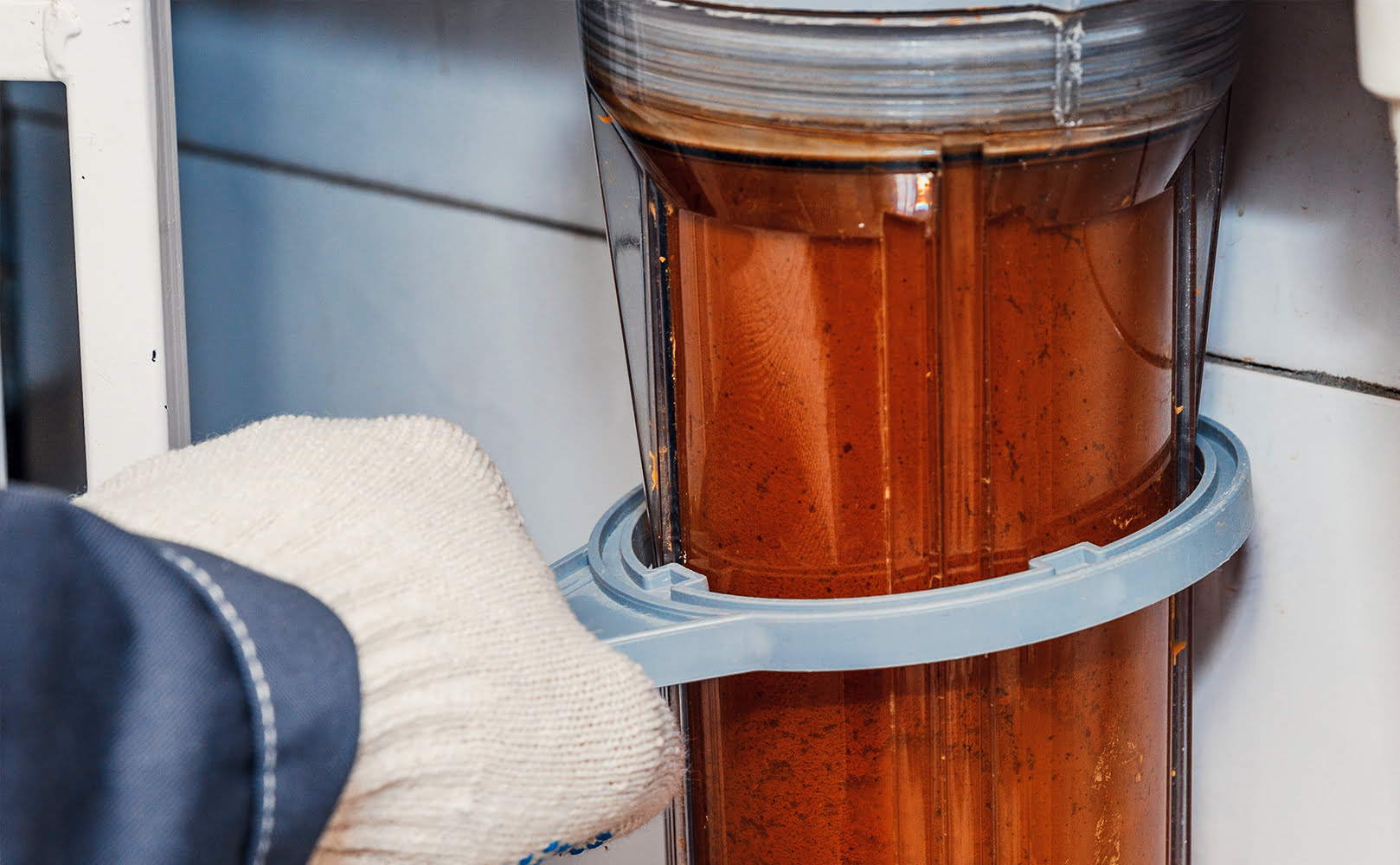5 Best Spin-Down Sediment Water Filters (*Update 2024)
Written by: Gene Fitzgerald // Expert Fact-Checking: Buddhini Dolapihilla, MBSS // Last Updated: Jan 31, 2024
This page may contain affiliate links. If you buy a product or service through such a link we earn a commission at no extra cost to you. Learn more.
Top Pick: What’s the Best Spin-Down Sediment Water Filter?
The best spin-down sediment water filter in 2024 is the USWS Centrifugal Sediment Spin-Down Filter, because it is affordable yet highly effective, made in USA, has a wide range of mesh sizes (micron ratings) to choose from, and is easy to flush, clean, and reuse. Plus, 25 gpm water flow is enough no matter how large your home.
In all honesty, choosing a spin-down sediment water filter is not as complicated as it may seem. Still, with dozens of models on the market, as well as different types, sizes, and micron ratings, you might feel a bit overwhelmed.
No worries, we’ve reviewed 12+ products! Spending several days researching and comparing, we can now provide you with a complete buying guide – which we are also working on improving regularly. Hopefully, you find it useful…
No Time to Read? Check Our List of the Best Spin-Down Filters!
| Product | Details | |
|---|---|---|
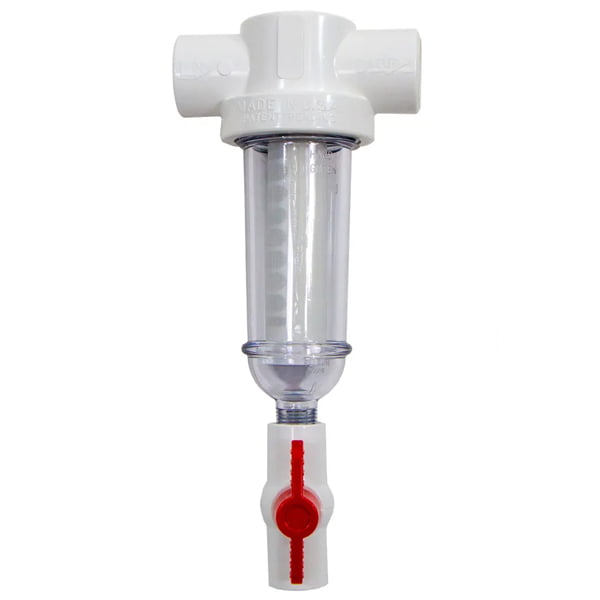 Best: USWS Centrifugal Sediment Spin-Down Filter |
Overall Rating: 5.0/5.0 ⓘRatings based on sediment removal, flow rates, ease of use, price tag, our testing, third-party ratings, product support and warranty, and other factors.
|
Price: $$ Mesh Size (Micron Rating): 24-1,000 (15-711 Microns) Flow Rate: 25 Gallons Per Minute Warranty: Not Specified Read Review: Click |
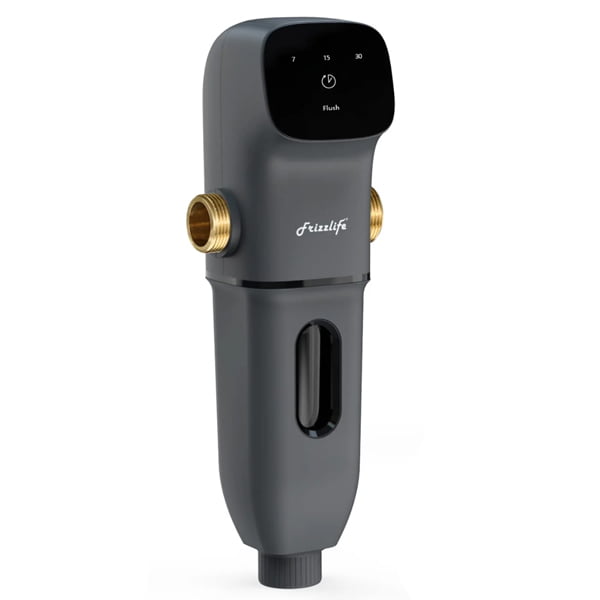 Best for Auto-Flushing: Frizzlife JX800 |
Overall Rating: 4.5/5.0 ⓘRatings based on sediment removal, flow rates, ease of use, price tag, our testing, third-party ratings, product support and warranty, and other factors.
|
Price: $$$ Mesh Size (Micron Rating): 40 Microns Flow Rate: 20 Gallons Per Minute Warranty: 1 Year Read Review: Click |
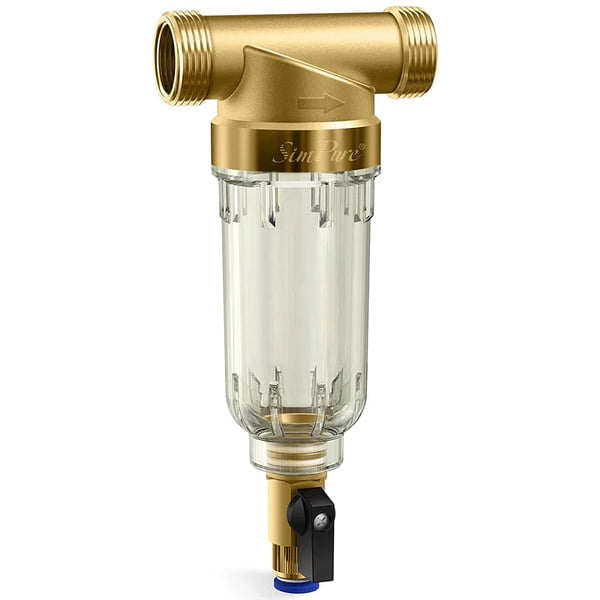 Best Budget Option: SimPure DC5P |
Overall Rating: 5.0/5.0 ⓘRatings based on sediment removal, flow rates, ease of use, price tag, our testing, third-party ratings, product support and warranty, and other factors.
|
Price: $ Mesh Size (Micron Rating): 40 or 200 Microns Flow Rate: 13-17 Gallons Per Minute Warranty: 1 Year Read Review: Click |
Spin-Down Filter Reviews
Our Top Picks
- USWS Centrifugal Sediment Spin-Down Filter – Best Overall
- Frizzlife JX800 – Best for Auto-Flushing
- SimPure DC5P – Best for Small Budgets
- SpringWell Spin-Down Sediment Filter
- Waterdrop Spin-Down Sediment Filter – Best for 50-Micron Filtration
1. Best Overall: USWS Centrifugal Sediment Spin-Down Filter
In our opinion, the best spin-down sediment filter in 2024 is the USWS Centrifugal Sediment Spin-Down Filter. Its primary advantage is its ease of use and reusability.
Other Specs
- Model: 412-075-F
- Last Price: $71.95- $74.95
- WxHxD: 7.25″x11.375″x7.25″
- Water Temperature: Up to 100 °F
- Water Pressure: Up to 150 psi
- Fitting: ¾” FPT
- Drain Fitting: ½” FPT
Key Features & Pros
- Made in the USA.
- Affordable price point.
- The simple centrifugal spin-down particulate filter removes sediment, sand, rust, and other debris inexpensively.
- A wide range of mesh sizes and micron ratings are available depending on your filtration needs:
- Mesh sizes 24/30/40 (771/533/381 microns): For general use in removing course sand, shale, shell, and debris.
- Mesh size 60 (254 microns): For sprinklers, aerators, and sand/pipe scale removal.
- Mesh sizes 100/140 (152/104 microns): For fine sand and grit removal.
- Mesh sizes 250/500 (61/30 microns): For very fine sand and grit pretreatment.
- Mesh size 1000 (15 microns): Ultra-fine dust and powder removal for reverse osmosis pre-filtration.
- Many of the above filters are available with polyester mesh if desired.
- Easy to flush and reuse.
- The see-through design allows you to view the accumulated sediment and determine when to clean it.
- To flush most of the accumulated sediment from the filter simply open the ball valve at the bottom for several seconds.
- Full cleaning is also straightforward.
- Tool-free cover removal.
- The flow rate is an impressive 25 gallons per minute, more than enough to accommodate large homes and buildings with up to 7 or more bathrooms.
Cons
- The manufacturer claims the system is IAPMO-certified for low lead, but to our knowledge there is no documentation available online to back this up.
Our Rating
- Filtration Performance: 5.0/5.0
- Filter Life: 5.0/5.0
- Price: 5.0/5.0
- Maintenance Cost: 5.0/5.0
- Overall: 5.0/5.0
Best for
If you’re looking for a quality, American-made spin-down sediment filter with a wide variety of sizes available then the USWS Centrifugal Sediment Spin-Down is the best option.
2. Best for Auto-Flushing: Frizzlife JX800 Whole House Spin-Down Filter
If you prefer some advanced features like auto-flushing, make sure to check out the Frizzlife JX800 Whole House Spin-Down Filter.
Other Specs
- Model: JX800
- Last Price: $125.99
- WxHxD: 3.9″x13″x4.7″
- Water Temperature: 39-100 °F
- Water Pressure: 20-125 psi
- Fitting: ¾”-1″ NPT
Key Features & Pros
- 40-micron spin-down pre-filter prolongs the lifespan of your home’s appliances as well as any point-of-use water filters installed.
- The filter will remove sand, silt, dirt, and other particles down to 40 microns.
- Auto flush design allows you to “install and forget” the system.
- The Auto Flush will run automatically at a pre-set interval (either 7, 15, or 30 days depending on your preference) and flush out accumulated debris for 15 seconds.
- The automatic self-cleaning design means you only need to manually clean out the sediment filter once per year.
- Transparent filter housing means you can see the level of accumulated debris without opening the filter.
- To clean, simply rotate the bottom caps, disconnect the black outer casing, and unscrew the housing using the included wrench. Then, remove the durable stainless-steel mesh filter and scrub it clean with a clean brush and unscented bleach.
- The system includes a control panel and electronic display allowing you to easily set the flush interval period as well as a manual flush button.
- Does not require an electrical outlet as it’s battery-powered.
- An impressive 20-gallon-per-minute flow rate is enough to accommodate larger homes with up to 7+ bathrooms.
- Installation is simple and can be performed on your own without any special tools.
- Comes with adapters for 3 different common plumbing line sizes.
- Batteries are included.
- Durable brass fittings prevent leaks and malfunctioning.
Cons
- Nothing so far.
Our Rating
- Filtration Performance: 4.0/5.0
- Filter Life: 5.0/5.0
- Price: 4.5/5.0
- Maintenance Cost: 5.0/5.0
- Overall: 4.5/5.0
Best for
The Frizzlife JX800 Whole House Spin-Down Filter is best for a spin-down sediment filter that cleans itself automatically.
3. Best for Low Budgets: SimPure DC5P Whole House Spin-Down Sediment Filter
Your budget is limited? We’ve got the perfect solution for you: The SimPure DC5P Whole House Spin-Down Sediment Filter for both well water and tap water.
Other Specs
- Model: DC5P
- Last Price: $44.99
- Fitting: ¾”-1″ NPT
Key Features & Pros
- The SimPure DC5P whole house spin-down sediment filter will protect pipes and household appliances by trapping debris, rust, sediment, sand, bits of limescale, and other particles.
- Uses centrifugal force to push sediments to the filter periphery, where they settle at the bottom.
- This filter comes with two mesh sizes (choose either 40 or 200 microns), depending on your water source.
- The manufacturer recommends the 40-micron filter for municipal water and the 200-micron filter for well water.
- Filter has a flow rate of 13 to 17 gallons per minute, which is less than the other models reviewed, but is still sufficient for homes with 4 to 6 bathrooms.
- Like other spin-down sediment filters, the filter’s primary advantage is its reusability and ease of cleaning. This means the filter can be used for years before replacement is needed.
- To clean the filter, simply open the valve at the filter bottom, and flush to purge away accumulated sediments.
- The manufacturer recommends flushing every 15 to 30 days and manually cleaning the filter every 3 to 6 months.
- Installation is straightforward with included adapters, Teflon plumber’s tape, and wrench.
- High-quality construction is built to last.
- Durable reinforced brass head, high efficiency and food grade stainless steel mesh, and anti-freezing and anti-water hammer resistance.
- Affordable price point.
Cons
- Some users had issues with leaking which were resolved by applying more plumber’s tape.
Our Rating
- Filtration Performance: 4.5/5.0
- Filter Life: 5.0/5.0
- Price: 5.0/5.0
- Maintenance Cost: 5.0/5.0
- Overall: 5.0/5.0
Best for
The SimPure DC5P Whole House Spin-Down Sediment Filter is the best whole house spin-down sediment filter on a budget.
4. SpringWell Spin-Down Sediment Filter (by Rusco)
This Rusco spin-down sediment filter sold by SpringWell is the best alternative to the model by US Water Systems from the very top.
Other Specs
- Model: Rusco-SDSF
- Last Price: $105.23
- WxHxD: 5″x11.375″x5″
- Water Temperature: Up to 100 °F
- Water Pressure: Up to 150 psi
- Fitting: 1″
Key Features & Pros
- This simple spin-down sediment filter from Rusco is designed to remove large sediment particles.
- 100 mesh screen gives the filter a 152-micron rating.
- Like other spin-down filter systems, the unit is reusable and easy to clean.
- Purging the filter is easy. Simply open the ball valve at the bottom and flush out the accumulated sediment.
- Transparent plastic housing allows you to view the amount of accumulated sediment inside the filter.
- For a more thorough cleaning, the housing can be unscrewed from the head without any tools (using tools will void the warranty).
- The filter has an impressive 25-gallon-per-minute flow rate – making it ideal for any-sized home.
- Installation is easy and can be done on a DIY basis provided you have basic skills.
- 1-inch inlet and outlet plumbing connections.
- 6-month money-back satisfaction guarantee in case you aren’t happy for any reason.
- Lifetime manufacturer warranty.
Cons
- Fairly coarse filter – not designed to filter out fine particulates.
Our Rating
- Filtration Performance: 4.0/5.0
- Filter Life: 5.0/5.0
- Price: 4.0/5.0
- Maintenance Cost: 5.0/5.0
- Overall: 4.5/5.0
Best for
This Rusco is best for anyone looking for a well-made spin-down filter with a solid warranty and satisfaction guarantee.
5. Best for 50-Micron Filtration: Waterdrop Spin-Down Sediment Filter
All you need is 50-micron sediment filtration and that’s it? Try the Waterdrop!
Other Specs
- Model: Waterdrop Spin-Down Sediment Filter
- Last Price: $59.99
- Water Temperature: 41-100 °F
- Water Pressure: 14.5-72 psi
- Fitting: ¾”-1″ NPT
Key Features & Pros
- Affordable pricing.
- The 50-micron-rated filter mesh removes rust, sand, dirt, sediment, and other large particulates.
- Extends the lifespan of your water-consuming appliances, plumbing lines, and any filter systems downstream.
- 20 gallon per minute flow rate is enough to accommodate larger homes with significant water demands.
- Installation is simple.
- The system comes bundled with four different-sized thread fittings (1” MNPT, 3/4″ FNPT, 3/4″ MNPT, and 3/4” push-fit plumbing fittings) so you can install it right out of the box.
- The backwash function allows you to flush the system of built-up particles in seconds.
- The manufacturer recommends flushing the system every 10 to 30 days.
- 1-year manufacturer’s warranty.
- 30-day money-back satisfaction guarantee in case you’re not happy for any reason.
Cons
- We will update this if something comes up.
Our Rating
- Filtration Performance: 4.0/5.0
- Filter Life: 5.0/5.0
- Price: 5.0/5.0
- Maintenance Cost: 5.0/5.0
- Overall: 4.5/5.0
Best for
If you’re looking for a well-made 50-micron spin-down sediment filter, then the Waterdrop makes an ideal choice.
Comparison List
(Mobile Hint: Swipe to Scroll)
| Model | Price | Micron Rating | Water Flow | Warranty | Additional Info | |
|---|---|---|---|---|---|---|
| US Water Systems Centrifugal Sediment Spin-Down Filter | $$ | 15-711 Microns | 25 gpm | ? | ||
| Frizzlife JX800 Whole House Spin-Down Filter | $$$ | 40 Microns | 20 gpm | 12 Months | ||
| SimPure DC5P Whole House Spin-Down Sediment Filter | $ | 40 or 200 Microns | 13-17 gpm | 12 Months | ||
| SpringWell Spin-Down Sediment Filter (by Rusco) | $$$ | 152 Microns | 25 gpm | Lifetime | ||
| Waterdrop Spin-Down Sediment Filter | $$ | 50 Microns | 20 gpm | 12 Months |
Buying Guide: How to Choose the Spin-Down Sediment Filter That’s Best for You
The following are key features worth considering when shopping for a spin-down sediment filter. They will help you choose the right on for your needs and budget.
Well or City Water
The first thing you’ll want to consider is your home’s water source.
Well water is also more likely to have more and larger-sized particles that require filtration than municipal water. Municipal water treatment facilities will typically remove these larger particulates, but if you have well water you’ll need to remove them yourself.
The bottom line is if you’re water is supplied by a well, you’re more likely to need a coarser-grain filter capable of removing larger volumes of sediment – like a spin-down filter.
The Type of Sediment in Your Source Water
Sediment can come from a variety of sources, including silt, dust, sand, clay, shale, pipe scale, or rust from old plumbing lines.
As mentioned previously, well water tends to have significantly more sediment than normal municipal water, as it doesn’t undergo any form of pre-treatment. This is especially true in springtime when runoff and snow melt flow into wells and bring debris with them.
You can usually tell if your water has sediment in it if your home’s faucet aerators clog or if your water has a murky look to it, but you can also fill a 5-gallon bucket with water and examine the bottom for sediments. Professional water testing for sediment is also very cheap.
Once you have an idea of the type and size of sediment you’re dealing with, you’ll be better able to pick the correct size spin-down filter.
The Right Micron Rating (Mesh Size)
When it comes to spin-down sediment filters, perhaps the most important metric to be aware of is their micron/mesh size. Micron ratings refer to the size of the particle that the filter will remove. So, for instance, a 50-micron filter will remove any particle larger than 50 microns, but allow anything smaller than 50 microns to pass through untouched.
Microns and mesh size are related, as the mesh size in the filter determines the micron size the filter will remove – but more on this later.
The right mesh size/micron rating for your situation will depend on the type of debris or sediment in question. Spin-down filters are generally better at removing larger debris, although smaller micron ratings are also available.
One thing to keep in mind when it comes to micron ratings is finer the micron size, the more likely the filter is to clog when exposed to heavy sediment. This is less of an issue with spin-down filters, as they can easily be flushed and reused many times, but it’s still something to remember.
Installation
When it comes to installation, spin-down sediment filters tend to be fairly easy to install. All that’s required is connecting the system to your home’s main water line where it enters the home. This can require cutting into the water line, but this is not as hard as it sounds.
Unlike other whole house systems, spin-down filters are compact, don’t require complex mounting or positioning, and don’t require extensive flushing or priming before use.
Flushing and Cleaning
When it comes to flushing and cleaning, spin-down sediment filters tend to be some of the easiest filter systems to deal with. Most have a built-in valve that when opened causes the trapped sediment to be flushed down the drain line in seconds.
While flushing out accumulated sediment is typically recommended every 2 to 4 weeks, spin-down filters generally also require occasional deep cleaning. This consists of removing the filter housing and mesh and scrubbing them with either soap or bleach.
Flow Rates (Water Pressure)
Flow rates refer to the maximum capacity of a water treatment system to process water at any given time. It’s typically measured in gallons per minute (gpm) and sometimes manufacturers will also provide a figure for the number of bathrooms a system can accommodate. A system with too low of a flow rate can cause low-pressure issues when multiple water outlets are run simultaneously.
Spin-down filters, due to their simple design, tend to have higher flow rates in the 15 gpm+ range, which means they don’t tend to cause low-pressure issues – even in larger homes.
Product Warranties
Spin-down sediment filters tend to be fairly inexpensive compared to other system types, so product warranties are less of a concern. Nonetheless, it’s still nice to have a solid warranty in case anything happens to go wrong.
Another plus is a decent satisfaction guarantee, as this allows you to return the product for a full refund no matter what the reason is.
Cost
Spin-down filters tend to be highly affordable – with most retailing somewhere in the $50 to $150 range. Combine this with the fact that they rarely require cartridge replacements and the ongoing costs of operating a spin-down filter are extremely low.
More on Spin-Down Filters
What Is a Spin-Down Sediment Filter?
A spin-down sediment filter is a filter that’s designed to remove large-sized sediment from water. Unlike fine micron sediment filters, they’re specifically used for large hunks of debris and sediment.
They use centrifugal force to divert water from your main water line and spin it through the filter housing. This centrifugal motion forces dirt and debris to the outside of the filter where it sinks to the bottom and remains until being flushed out.
The flushing is done by opening a ball valve at the bottom of the filter housing. This valve is usually directly connected to a drain.
Mesh Sizes vs Micron Ratings
Mesh sizes refer to the number of holes per inch in a given filter mesh. Lower mesh sizes indicate a courser mesh with a higher micron rating, while higher mesh sizes indicate a finer mesh with a lower micron rating.
As a general guideline, size 24 – 40 mesh (381 to 711 microns) are used for removing coarse sand, shale, debris, and scale. Size 60 to 140 mesh (254 to 104 microns) are used for removing fine sand, while size 250 to 1000 mesh (61 to 15 microns) are used for removing very fine sand, grit, powder, and dust.
There is no official formula for converting between mesh and microns, so make sure to consult the mesh/micron specifics and manufacturer recommendations for your particular filter.
That said, we can make a fairly accurate conversion using the following formula:
Micron = 14,900/Mesh, or Mesh = 14,900/Micron
Generally speaking, it’s recommended to choose the coarsest mesh you can that will still remove the required contaminants. This will prevent the filter from clogging as much, and reduce the amount of flushing/cleaning you need to perform.
Types: Spin-Down Filters vs Sediment Trappers
Spin-down filters can be further divided into two types: Regular spin-down filters and sediment trappers.
The basic design of the head and housing is identical, with the main difference being that sediment trappers have an increased capacity for trapping sediment. They accomplish this by using a shorter filter with a stem at the bottom for dirt and debris to accumulate.
If you’re dealing with a significant amount of sediment in your water, then a sediment trapper will give you more time in between each flushing.
What Does a Spin-Down Filter Remove from Water?
Spin-down filters remove sediment and not much else. That means sand, dirt, rust, bits of scale, debris, dust, and the like. As mentioned previously, the size of particles that a filter can remove will depend on the mesh/micron rating.
If you have other contaminants that need removal besides floating particulates, then you’ll need additional filtration to get rid of them.
Pros & Cons of Spin-Down Sediment Filters
Let’s take a look at both the pros and cons of using a spin-down sediment filter.
Pros
Protects Your Plumbing System and Water-Using Appliances
Sediment in your water can damage your water-consuming appliances and plumbing over time. This will lead to expensive repairs and maintenance which can end up costing thousands of dollars in the long run.
A spin-down filter will effectively remove this sediment from your water, ensuring your plumbing, dishwasher, washing machine, water heater, and other appliances are free from sediment accumulation. Furthermore, it accomplishes this at a very low price point when compared to other sediment filter systems.
Protects Your Other Water Treatment Equipment
In addition to plumbing and appliances, a spin-down filter is useful for protecting other water treatment systems from sediment accumulation and damage. If you have another filter system installed, like reverse osmosis, activated carbon, or a water softener, then installing a spin-down filter is a cheap way to protect your investment.
Visually Cleaner Water
Water with significant sediment accumulation can appear turbid or cloudy, and can even take on a brown, red, or yellow coloration depending on the contaminant source. It can also leave fine particles behind in tubs, sinks, and the like.
Spin-down filters are one of the best ways to remove this turbidity and discoloration from your water, leaving you with clear, clean-looking water.
Keep in mind that some discoloration can be caused by the presence of contaminants like iron or manganese, which will require additional filtration beyond spin-down filters.
Easy to Install, Use, and Maintain
Spin-down filters are some of the easiest filter systems to install, use, and maintain on the marker.
Installation is probably the most difficult of the three, and even this can be accomplished in minutes with basic tools. Using the system doesn’t require anything other than turning on your tap while the filter does the rest. Maintenance requirements are also very low, with only periodic flushing and occasional cleaning required.
Affordable
Perhaps the biggest advantage of spin-down sediment filters is their price point. With many retailing for less than $100, you’ll get an impressive level of sediment removal for the cost of many pitcher-style filters.
Reusable
Unlike other sediment filters, many spin-down systems are designed to last for 1 to 2+ years before needing replacement. Compare this with other filter cartridge types, which typically last for 3 to 6 months, and you can see the advantage inherent to spin-down filters.
Clear Filter Housing
Most spin-down filters come with clear filter housings – allowing you to view the accumulated sediment inside the housing. This gives you an easy way to check when it’s time to flush the accumulated sediment without needing to open the filter.
Auto Flush
Some spin-down filters come with an auto-flush function which means they do not need to be flushed manually but rather will flush themselves at regular intervals. Auto-flush valves can also be purchased as an optional add-on in many cases.
This further reduces the maintenance required and makes a system nearly maintenance-free.
Cons
Doesn’t Remove Dissolved Particles
Spin-down sediment filters are only capable of removing suspended or floating particles and not dissolved particles. That means they can’t remove TDS (total dissolved solids) from your water.
Doesn’t Reduce Water Hardness
Related to the above, spin-down sediment filters can’t remove water hardness as most hardness minerals are dissolved in the water. This isn’t their intended purpose though, so it’s not much of a disadvantage.
Where to Install
Typically, you want to install a spin-down sediment filter immediately after the pressure tank on a well water system. If installing on municipal water, then you want to install it where the main water line enters the home.
If you have another water filter system installed, then you want to install the spin-down filter before the other system.
Maintenance: How to Flush and Clean a Spin-Down Sediment Water Filter
Flushing and cleaning spin-down filters are very simple tasks, but they must be done regularly to keep the system functioning correctly.
To flush a spin-down filter, simply open the flush valve at the bottom of the filter. This will remove the accumulated sediment in seconds and doesn’t require you to remove the mesh from its housing.
While flushing the filter will rapidly remove any accumulated sediment, spin-down filters will still require occasional cleaning of the filter screen to remove clogging. To do this follow these steps:
- Separate the filter housing from the unit head.
- Remove the screen from the housing.
- Clean the screen by scrubbing it with a brush, dish soap, and water.
- Rinse and dry the filter and then replace it inside the filter housing.
How Often Does a Spin-Down Filter Require Maintenance?
The exact maintenance interval will vary from system to system as well as how often you use the system and your water quality. In general, though, spin-down filters need flushing every 10 to 30 days, and manual cleaning every 3 to 12 months.
What Are Sediments?
In terms of water filtration, sediments refer to suspended solids like sand, silt, clay, dirt, rust, and other debris. The important thing to keep in mind is these sediment particles are not dissolved but rather suspended in the water.
Sediments in your water can cause turbidity, discoloration, as well as clogging of plumbing valves, fixtures, appliances, and water filter systems.
Frequently Asked Questions (FAQ)
- What is the best micron size for a spin-down filter?
This entirely depends on your water conditions. You should choose your spin-down filter’s micron size based on the size of the sediments in your water supply (have it tested). Generally speaking, well water contains more and larger sediment. - Why use a spin-down sediment filter?
A spin-down sediment filter is the ideal first defense against heavily contaminated (well) water. It comes into play where other types of water filters would rapidly clog. - How often do you replace spin-down filters?
Usually, you can clean and reuse the mesh in a spin-down water filter for at least 1-2 years. - Should a spin-down filter go before or after the pressure tank?
In most cases, the filter should go after the pressure tank. - What is the difference between spin-down and regular sediment filters?
Spin-down filters use a removable filter mesh that can be cleaned and reused. Most spin-down filters are also flushable. Regular sediment filters use filter cartridges which need to be replaced periodically, like every 6 months.
How We Chose and Tested the Best Spin-Down Sediment Water Filters (Why Trust Us)
Here is the expert approach we took to review spin-down sediment water filters:
- To begin, we developed a list of benchmark criteria comprising 14 attributes. These criteria served as a comprehensive framework for evaluating all spin-down filters, enabling us to conduct a thorough assessment.
- Next, we went above and beyond by compiling a list of over 13 products online. This list included both well-established brands and newer options, allowing us to assess a comprehensive overview of the market.
- Our evaluation process commenced with an in-depth analysis of product manuals, descriptions, and third-party testing and certifications where available. Of course, we also checked for product warranties.
- Seeking further insights, we engaged directly with representatives from some of the brands such as USWS and SpringWell. By posing as potential customers, we assessed the level of support provided by each brand.
- We also ensured the inclusion of authentic user perspectives, enhancing the overall reliability of our reviews. In other words, we looked everywhere online for what people had to say about the spin-down filters we had marked down.
- Recognizing the importance of firsthand experience, we took additional steps to validate our findings. We ordered and installed a selection of the 5 remaining products on a suitable water supply. Through this hands-on approach, we assessed each system’s performance, considering factors such as ease of installation and filter flushing.
- Finally, it was time to compile all the gathered info into an easily digestible format, presenting our readers with a clear understanding of the strengths and weaknesses of each spin-down sediment filter. Each review was meticulously crafted, completely independent, unbiased, and thoroughly fact-checked.
About Our Ratings
We’ve rated each system on a score of 1 to 5, with 5 being the highest rating.
Currently, our evaluation is mostly based on these key factors: Sediment reduction (25%), flow rates (20%), ease of use (20%), affordability (15%), testing and user opinions (10%), customer support/warranty (10%).
Questions? Ask away!
Information provided on BOS is for educational purposes only. The products and services we review may not be right for your individual circumstances.
We adhere to strict editorial guidelines. Rest assured, the opinions expressed have not been provided, reviewed, or otherwise endorsed by our partners – they are unbiased, independent, and the author’s alone. Our licensed experts fact-check all content for accuracy. It is accurate as of the date posted and to the best of our knowledge.

